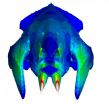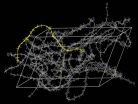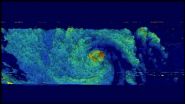(Press-News.org) AMHERST, Mass. – The surprise discovery of the fossilized skull of a 66- to 70-million-year-old, groundhog-like creature on Madagascar has led to new analyses of the lifestyle of the largest known mammal of its time by a team of specialists including biologist Elizabeth Dumont at the University of Massachusetts Amherst, an expert in jaw structure and bite mechanics.
The skull of this animal, named Vintana sertichi, was found in a geological formation deposited when a great variety of dinosaurs roamed the earth. With a skull that is almost five inches (125 mm) long, it was double the size of other mammals from the southern supercontinent, Gondwana, during the Age of Dinosaurs. The authors estimate a body mass of about 20 lbs. (9 kg). Findings appear in the current issue of Nature.
The well-preserved skull allows a wealth of insights into the life habits and relationships of early mammals of the Upper Cretaceous age, Dumont says. "My part in this huge interdisciplinary effort was to reconstruct the skull and model the mechanics of chewing and estimate the animal's ability to eat different kinds of foods."
Dumont and her assistant Dan Pulaski reconstructed the cranium from CT scans by painstakingly moving bone fragments back into place and filling in missing bone with mirror images of the same bone from the other side of the skull. Dumont reconstructed the chewing muscles based on comparison to living rodents and used engineering-based models to predict how the jaws moved and how hard the animal could bite.
Vintana's massive chewing muscles moved the jaw upward and backward and likely produced higher bite forces than living rodents of similar body size. Based on characteristics of its jaws and teeth and analyses by Dumont and others, the authors believe it ate a diet of roots, seeds or nut-like fruits.
Vintana belongs to a group of early mammals known as gondwanatherians, until now known only from isolated teeth and a few jaw fragments. The well-preserved skull allows the first clear insight into the life habits and relationships of gondwanatherians.
Dumont and lead author, paleontologist David Krause of Stony Brook University, agree that the discovery shakes up evolutionary biologists' views of the mammalian "family tree." Krause says Vintana "reshapes some major branches" of that tree, grouping gondwanatherians with others that have been "very difficult to place." Dumont adds, "This work is a real tour de force thanks to the collaboration of many different specialists."
Krause also points out, "We know next to nothing about early mammalian evolution on the southern continents. This discovery, from a time and an area of the world that are very poorly sampled, underscores how very little we know. No paleontologist could have come close to predicting the odd mix of anatomical features that this cranium exhibits."
Krause and colleagues discovered the skull in 2010 by chance. It is only the third mammalian skull to be recovered from the Cretaceous in the Southern Hemisphere.
Specialists including Dumont conducted a comprehensive analysis of the skull using micro-computed tomography and scanning electron microscopy to reveal very small anatomical details in areas such as the braincase, nasal cavity and inner ear that are poorly known in nearly all early mammals. Dumont and colleagues compared the skull to those of hundreds of other fossil and extant mammals and concluded that it likely had large eyes, the ability to hear high frequency sounds and a good sense of smell.
With the addition of this new information on cranial anatomy of gondwanatherians, which was previously completely unknown, the researchers also explored its possible relationships to other early mammals. Their analysis is the first to find strong evidence that Vintana was probably closely related to multituberculates, the most successful mammalian contemporaries of dinosaurs on the northern continents, and early herbivores known as Haramiyida.
Madagascar had been an island for over 20 million years prior to the time in which the strata containing Vintana were deposited. The researchers theorize that the primitive and unusual features of its skull are holdovers from when the ancient landmass was cut off from Africa, Antarctica and Australia, and finally the Indian subcontinent.
INFORMATION:
This work was supported by the National Science Foundation and the National Geographic Society.
Madagascar: Fossil skull analysis offers clue to mammals' evolution
The well-preserved skull allows a wealth of insights into the life habits and relationships of early mammals of the Upper Cretaceous age
2014-11-05
ELSE PRESS RELEASES FROM THIS DATE:
New global wildfire analysis indicates humans need to coexist and adapt
2014-11-05
A new study led by the University of California, Berkeley and involving the University of Colorado Boulder indicates the current response to wildfires around the world—aggressively fighting them—is not making society less vulnerable to such events.
The study suggests the key is to treat fires like other natural hazards—including earthquakes, severe storms and flooding—by learning to coexist, adapt and identify vulnerabilities. The new study indicates government-sponsored firefighting and land management policies may actually encourage development ...
Bone drug should be seen in a new light for its anti-cancer properties
2014-11-05
Australian researchers have shown why calcium-binding drugs commonly used to treat people with osteoporosis, or with late-stage cancers that have spread to bone, may also benefit patients with tumours outside the skeleton, including breast cancer.
Several clinical trials – where women with breast cancer were given these drugs (bisphosphonates) alongside normal treatment for early-stage disease – showed that they can confer a 'survival advantage' and inhibit cancer spread in some women, although until now no-one has understood why.
A new study by Professor ...
Clearing a path for electrons in polymers: Closing in on the speed limits
2014-11-05
Researchers from the University of Cambridge have identified a class of low-cost, easily-processed semiconducting polymers which, despite their seemingly disorganised internal structure, can transport electrons as efficiently as expensive crystalline inorganic semiconductors.
In this new polymer, about 70% of the electrons are free to travel, whereas in conventional polymers that number can be less than 50%. The materials approach intrinsic disorder-free limits, which would enable faster, more efficient flexible electronics and displays. The results are published today ...
Sustainable co-existence with wildfire recognizes ecological benefits, human needs
2014-11-05
CHICAGO (November 5, 2014) – When wildfire and people intersect, it is often in the wildland-urban interface, or WUI, a geography where homes, roads and trails intermix with fire-prone vegetation. In an article published Thursday in the journal Nature, U.S. Forest Service scientist Sarah McCaffrey and her colleagues advocate for an approach to wildfire management that reflects ecological science as well as research on the human dimensions of wildfire and fire management.
"Learning to Coexist with Wildfire," a research review led by the University of California-Berkley, ...
Readmission rates above average for survivors of septic shock, Penn study finds
2014-11-05
PHILADELPHIA –A diagnosis of septic shock was once a near death sentence. At best, survivors suffered a substantially reduced quality of life.
Penn Medicine researchers have now shown that while most patients now survive a hospital stay for septic shock, 23 percent will return to the hospital within 30 days, many with another life-threatening condition -- a rate substantially higher than the normal readmission rate at a large academic medical center. The findings are published in the new issue of Critical Care Medicine.
"Half of patients diagnosed with sepsis ...
High rate of insomnia during early recovery from addiction
2014-11-05
November 5, 2014 – Insomnia is a "prevalent and persistent" problem for patients in the early phases of recovery from the disease of addiction—and may lead to an increased risk of relapse, according to a report in the November/December Journal of Addiction Medicine, the official journal of the American Society of Addiction Medicine. The journal is published by Lippincott Williams & Wilkins, a part of Wolters Kluwer Health.
"Treating sleep disturbance in early recovery may have considerable impact on maintenance of sobriety and quality of life," according ...
Betting on brain research
2014-11-05
Despite great advances in understanding how the human brain works, psychiatric conditions, neurodegenerative disorders, and brain injuries are on the rise. Progress in the development of new diagnostic and treatment approaches appears to have stalled. In a special issue of the Cell Press journal Neuron, experts look at the challenges associated with "translational neuroscience," or efforts to bring advances in the lab to the patients who need them.
"A variety of global impact studies have identified brain disorders as a leading contributor to disabilities and morbidity ...
Risk stratification model may aid in lung cancer staging and treatment decisions
2014-11-05
DENVER – A risk stratification model based on lymph node characteristics confirms with a high level of confidence the true lack of lung cancer in lymph nodes adequately sampled with endobronchial ultrasound-guided transbronchial needle aspiration and classified as negative.
Lung cancer treatment and prognosis is critically dependent on accurate staging that takes into account the extent to which cancer has spread from the primary lung tumor to other locations. Examination of lymph nodes containing lung cancer cells that have spread can be done by surgical removal, ...
Retinal-scan analysis can predict advance of macular degeneration, Stanford study finds
2014-11-05
Stanford University School of Medicine scientists have found a new way to forecast which patients with age-related macular degeneration are likely to suffer from the most debilitating form of the disease.
The new method predicts, on a personalized basis, which patients' AMD would, if untreated, probably make them blind, and roughly when this would occur. Simply by crunching imaging data that is already commonly collected in eye doctors' offices, ophthalmologists could make smarter decisions about when to schedule an individual patient's next office visit in order to optimize ...
NASA's TRMM and GPM satellites analyze Hurricane Vance before landfall
2014-11-05
Hurricane Vance was a hurricane on Nov. 4 when the Tropical Rainfall Measuring Mission or TRMM satellite and the Global Precipitation Measurement (GPM) mission satellite passed overhead and measured its rainfall from space. TRMM and GPM revealed areas of heavy rain within the storm before it weakened to a depression and made landfall on Nov. 5.
The TRMM satellite flew over hurricane Vance on Nov. 4 at 0953 UTC (4:53 a.m. EST). Rainfall derived from TRMM's Microwave Imager (TMI) data collected were overlaid on a 1000 UTC (5 a.m. EST) image from NOAA's GOES-West satellite ...
LAST 30 PRESS RELEASES:
Chronic breathlessness emerging as a hidden strain on hospitals
Paleontologists find first fossil bee nests made inside fossil bones
These fossils were the perfect home for ancient baby bees
Not everyone reads the room the same. A new study examines why.
New research identifies linked energy, immune and vascular changes in ME/CFS
Concurrent frailty + depression likely boost dementia risk in older people
Living in substandard housing linked to kids’ missed schooling and poor grades
Little awareness of medical + psychological complexities of steroid cream withdrawal
Eight in 10 trusts caring for emergency department patients in corridors, finds BMJ investigation
NASA’s Webb telescope finds bizarre atmosphere on a lemon-shaped exoplanet
The gut bacteria that put the brakes on weight gain in mice
Exploring how patients feel about AI transcription
Category ‘6’ tropical cyclone hot spots are growing
Video: Drivers struggle to multitask when using dashboard touch screens, study finds
SLU research shows surge in alcohol-related liver disease driving ‘deaths of despair’
Rising heat reshapes how microbes break down microplastics, new review finds
Roots reveal a hidden carbon pathway in maize plants
Membrane magic: FAMU-FSU researchers repurpose fuel cells membranes for new applications
UN Member States pledge to increase access to diagnosis and inhaled medicines for the 480 million people living with COPD
Combination therapy shows potential to treat pediatric brain cancer ATRT
Study links seabird nesting to shark turf wars in Hawai‘i
Legal sports betting linked to sharp increases in violent crime, study finds
Breakthrough AI from NYUAD speeds up discovery of life-supporting microbes
New Eva Mayr-Stihl Foundation funding initiative boosts research at University of Freiburg on adaptation of forests to global change
The perfect plastic? Plant-based, fully saltwater degradable, zero microplastics
Bias in data may be blocking AI’s potential to combat antibiotic resistance
Article-level metrics would provide more recognition to most researchers than journal-level metrics
Satiety’s little helper: Protein that supports appetite regulating protein identified
UF dives deep into predicting storm damage with computer models
A stormy ocean voyage yields insights on the global carbon cycle
[Press-News.org] Madagascar: Fossil skull analysis offers clue to mammals' evolutionThe well-preserved skull allows a wealth of insights into the life habits and relationships of early mammals of the Upper Cretaceous age




